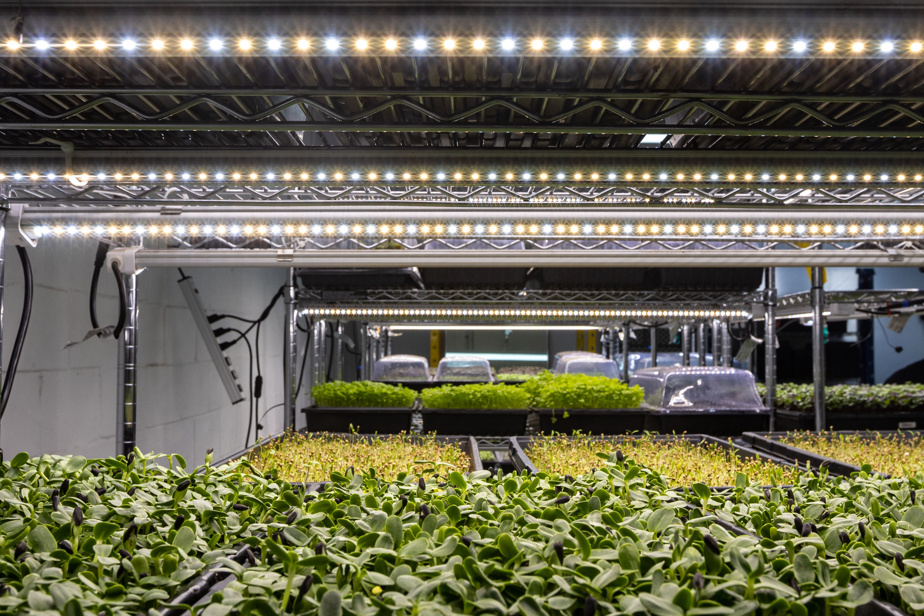When Martin Quintal founded Futur Vert in 2009, he did not expect such a fertile future.
The company
Initially, the entrepreneur simply wanted to make up for a lack, he who then had the project to create a berry greenhouse. When shopping for his lighting, this technology enthusiast couldn’t find what he was looking for and had to turn to systems from Asia. He then became an importer of LED lighting.
“It led me to push the development of this technology for vertical farms,” explains Martin Quintal.
Cannabis cultivation has paid off for the young company, which has honed its expertise in these greenhouses, vertical or horizontal. With the desire to increase our food sovereignty and grants to support projects, food production greenhouses have been growing in Quebec for 10 years. Urban farms are multiplying. Futur Vert’s bespoke light designs are perfect for those projects that don’t fit into traditional boxes.
innovation
Conventional greenhouses are lit with sodium lights which give off a lot of heat. One might think that this is an advantage, but not at all, since it is an uncontrolled heat. The proof, explains Martin Quintal, is that greenhouses often have to open their windows to evacuate the heat.
Big advantage for LEDs: the projected light is more precise. This adjusts the light spectrum and increases light performance, as well as maximizing production space. LED systems are more powerful and last twenty years, even in very humid environments.
Vision
By placing the light source very close to the plant, we can stage the plantations. This plant densification makes it possible to grow crops in the city, in places where one would not imagine setting up a farm.
“The advantage of indoor greenhouses is that you can do them anywhere,” says Martin Quintal. In an underground parking lot or on the roof of an office building. »
For example, who would believe that there is a mushroom farm… in the textile district, in Ahuntsic, in Montreal?
An example
Yet this is where Grenouille rouge set up shop, in a commercial building more popular with fabric importers than farmers.
“The Ahunstic-Chabanel district is really perfect for agricultural production,” nevertheless maintains Gabriel Roy-Doyon, one of the founders of Grenouille rouge, whose floors of microgreens and mushrooms are lit by Futur Vert.

PHOTO JOSIE DESMARAIS, THE PRESS
As this is an early stage in the development of the plant, 30 watts are enough for Red Frog microgreens and 20 for its mushrooms.
Guillaume Dagher and Gabriel Roy-Doyon, the duo behind this (almost!) secret farm, used a lot of recycled material to launch their project. For the lighting, it was necessary to invest in efficient installations, the lights being the replacement sun for the plants.
In addition to providing lighting solutions, Futur Vert has enabled Grenouille rouge to access expertise and discover other companies in the same niche, which promotes the transfer of valuable information for a company. in startup.
After only one year of operation, the small urban farm is doing well: already profitable, Grenouille rouge sells about 250 trays of microgreens and 200 pounds of mushrooms per week. For the moment, Montreal restaurants and a few specialized shops offer the products, essentially within a radius of 20 km from the place of production.
Grenouille rouge wants to continue its relationship with Futur Vert and, eventually, implement an aquaponics system to expand its offer, with fruits and vegetables.
The future
Martin Quintal now wants conventional greenhouse owners to turn to LED systems and change the way they view greenhouse growing.
“It doesn’t make sense to have a greenhouse in a big enclosed area on one production floor,” he says. We simply reproduced the field inside. »
Admittedly, this would require a significant initial investment, but it would also contribute to greening this mode of cultivation often pointed out as being very energy-intensive.
The entrepreneur dreams of seeing multidisciplinary researchers look into this question to pursue the sustainable development of indoor culture. Maybe develop vertical farm concepts where animals could be integrated. “What the earth has always done for millions of years, replicate it inside”, says Martin Quintal. By saving space, therefore energy. “You have to maximize the cubic meter,” he says. Rather than thinking only of the square meter. »
